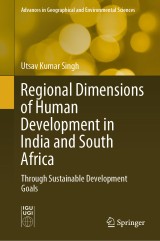Details

Regional Dimensions of Human Development in India and South Africa
Through Sustainable Development GoalsAdvances in Geographical and Environmental Sciences
|
160,49 € |
|
| Verlag: | Springer |
| Format: | |
| Veröffentl.: | 29.07.2024 |
| ISBN/EAN: | 9789819758463 |
| Sprache: | englisch |
| Anzahl Seiten: | 200 |
Dieses eBook enthält ein Wasserzeichen.
Beschreibungen
<p>This book offers a comparative study of the progress made by two regional economies with many similarities—India and South Africa—in pursuit of human development by applying Sustainable Development Goals (SDGs). In this effort, book traverses the stages in public policy from planning to implementation, and from reach to range, in pursuit of inclusive growth and well-being for all. The book includes cross-national qualitative as well as quantitative studies and deeper analyses of India, and South Africa in respect of long-term development goals.</p>
<p>This book attempted to solve the following puzzle: despite the stupendous growth rate, why is India's performance lower than South Africa's in terms of human development indicators? This book addresses this puzzle by drawing attention to welfare approaches. These two countries have unique federal structures that uphold the unbalanced states together, and this book argues that uneven development challenges need asymmetric strategies, contrary to the axiom that the SDGs are indivisible. Further advancement of India and South Africa depends on transforming their quantity (large youth population) into quality (human capital). Both countries are also striving to create platforms to unleash human potential, which is critically examined.</p>
<p>This book attempted to solve the following puzzle: despite the stupendous growth rate, why is India's performance lower than South Africa's in terms of human development indicators? This book addresses this puzzle by drawing attention to welfare approaches. These two countries have unique federal structures that uphold the unbalanced states together, and this book argues that uneven development challenges need asymmetric strategies, contrary to the axiom that the SDGs are indivisible. Further advancement of India and South Africa depends on transforming their quantity (large youth population) into quality (human capital). Both countries are also striving to create platforms to unleash human potential, which is critically examined.</p>
<p>Human Development in Paradigm of Sustainable Development Goals.- Sustainable Development Goals in India: Progress and Challenges.- Sustainable Development Goals in South Africa: Progress and Challenges.- Impact of UN's Sustainable Development Goals on Human Development in India and South Africa.- Conclusion and Way forward.</p>
<p>Dr. Utsav Kumar Singh is a fellow at the Institute of Social Science, New Delhi. He formerly served as an assistant professor at the Department of Economics, Shaheed Bhagat Singh College, University of Delhi (2020 – 2023), and as an Indian Council of Social Science Research (ICSSR) post-doctoral fellow at the Department of Political Science, University of Delhi (2019 – 2020). His research interests include comparative political economy, human geography, political institutions, and regional and cross-national qualitative and quantitative analyses of India and South Africa.</p>
<p>This book offers a comparative study of the progress made by two regional economies with many similarities--India and South Africa-- in pursuit of human development by applying Sustainable Development Goals (SDGs). In this effort, book traverses the stages in public policy from planning to implementation, and from reach to range, in pursuit of inclusive growth and well-being for all. The book includes cross-national qualitative as well as quantitative studies and deeper analyses of India, and South Africa in respect of long-term development goals.</p>
<p>This book attempted to solve the following puzzle: despite the stupendous growth rate, why is India's performance lower than South Africa's in terms of human development indicators? This book addresses this puzzle by drawing attention to welfare approaches. These two countries have unique federal structures that uphold the unbalanced states together, and this book argues that uneven development challenges need asymmetric strategies, contrary to the axiom that the SDGs are indivisible. Further advancement of India and South Africa depends on transforming their quantity (large youth population) into quality (human capital). Both countries are also striving to create platforms to unleash human potential, which is critically examined.</p>
<p>This book attempted to solve the following puzzle: despite the stupendous growth rate, why is India's performance lower than South Africa's in terms of human development indicators? This book addresses this puzzle by drawing attention to welfare approaches. These two countries have unique federal structures that uphold the unbalanced states together, and this book argues that uneven development challenges need asymmetric strategies, contrary to the axiom that the SDGs are indivisible. Further advancement of India and South Africa depends on transforming their quantity (large youth population) into quality (human capital). Both countries are also striving to create platforms to unleash human potential, which is critically examined.</p>
Analyses human development through Sustainable Development Goals (SDGs) Proposes asymmetric approach for uneven development challenges, contrary to the axiom that SDGs are indivisible Proposes a new development model to realise the dream of human development in India and South Africa
Diese Produkte könnten Sie auch interessieren:

Observing Systems for Atmospheric Composition

von: Guido Visconti, Pietro Di Carlo, W. Brune, M. Schoeberl, Andreas Wahner

149,79 €















